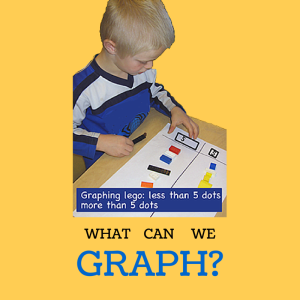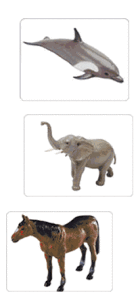There are many opportunities for graphing activities during the school day.
When young children learn to use graphs, they not only learn to organize information, they have an opportunity to practice literacy and social skills.
Simple graphing activities help children develop the skills of one-to-one correspondence counting, number recognition, and numbers and operations.
In the image below, the child wanted to sort the Lego™ blocks by the number of raised dots on each one (his idea!).
He put blocks with more than 5 dots on one side and blocks with fewer than 5 dots on the other.
A sample real graph activity
Materials:
- Plastic toy animals
- A graphing mat
- Place an animal with 2 legs at the top of one column on the graphing mat.
- Place an animal with 4 legs at the top of another column.
- Place an animal with no legs at the top of the third column.
Activity:
- Ask each child to choose a toy animal.
- Have the children sit in two rows on either side of the graphing mat.
- Ask children to place their animals one at time under the correct heading.
- A bar graph is the result.
Sample graphing questions:
Which column (teach vocabulary – column, row, fewer, same, different, more than, less than) has more animals?
Which column has fewer animals?
How many animals have no legs?
How many animals have 2 legs?
How many animals have 4 legs?
How many animals all together?
How many more animals are there with 4 legs than with 2 legs?
Ideas – what shall we graph?
Once you get the idea of how easy it is to graph, count, or tally items, the subject matter is endless. Here are a few suggestions to get you started. If possible have real things to graph, rather than pictures.
Body – A note on feeling different…
Young children may be easily upset if they are the only person whose results are on one side of a graph. E.g. Hair color – 6 kids with blonde hair, 5 kids with black hair, 8 kids with brown hair, one child with red hair. Be sensitive to the children in your class when choosing graphing topics.
Hair color
Eye color
Right handed or left handed
Food
Do you like… apples or oranges; pizza with meat, without meat Smarties® or Lifesavers®; cereals, vegetables, soups etc.
Books
Compare recently read books
Stories or non-fiction
Magazines or books
Colors
Which one of these colors do you like the best?
Which shade of yellow do you like the most?
Clothes
Do your pants have pockets or no pockets?
Do your shoes have Velcro® or no Velcro?
Is your shirt striped or plain?
Activities and Events
Do you like swimming or games?
Do you like daytime or nighttime
Do you like sunshine or rain
Do you like rain or snow
Do you like sunshine or snow
Do you like going to __ or ___ the best. Fill in with local restaurants.
Favorite holidays.. Easter or Christmas
How do I get to school? bike, walk, bus, car
Toys
My favorite stuffed animal is a…
Animals
I like dogs, cats, or fish the best
Toy animals
Graph number of legs
Horns or no horns
Short and long tails
Wild animals and farm animals
Pond animals and animals that don’t live in the pond
Number of pets in the home (another sensitive area if only one or two kids don’t have pets)
Letters and numbers
How many letters in your name?
How old are you?
How many people in your family?
Tips for Teaching Graphing
Competition – A few children perceive every activity as a competition and will proclaim, “My side won!” or “I won!” after each session. Continue to model the behavior you would like the children to have, in this case, an appreciation of graphs. This helps the children to see that graphing is not a competition, just a way to sort things and make it easier to understand information.
For example, with the animal example above, have the children choose an animal before they know that the graphing category is going to be numbers of animal legs. After graphing the animal by number of legs, have them graph their animal again using a different category, such as horns and no horns, hooves and no hooves, wild animals and not wild animals, short tails and not short tails.
Friends – With graphs such as “Which book did you like the most?”
Some children want to change their answer if their friends’ answers are different from theirs. Having each child put a marker or magnet under the category without their name on it usually solves this problem.

